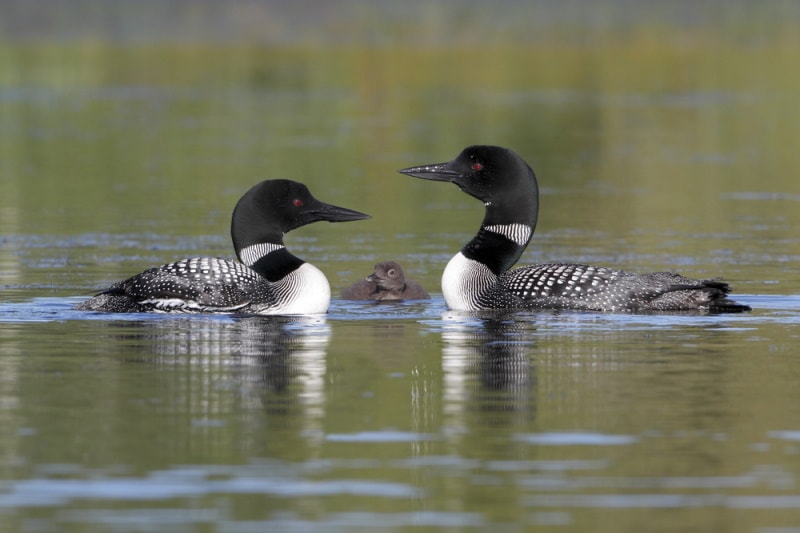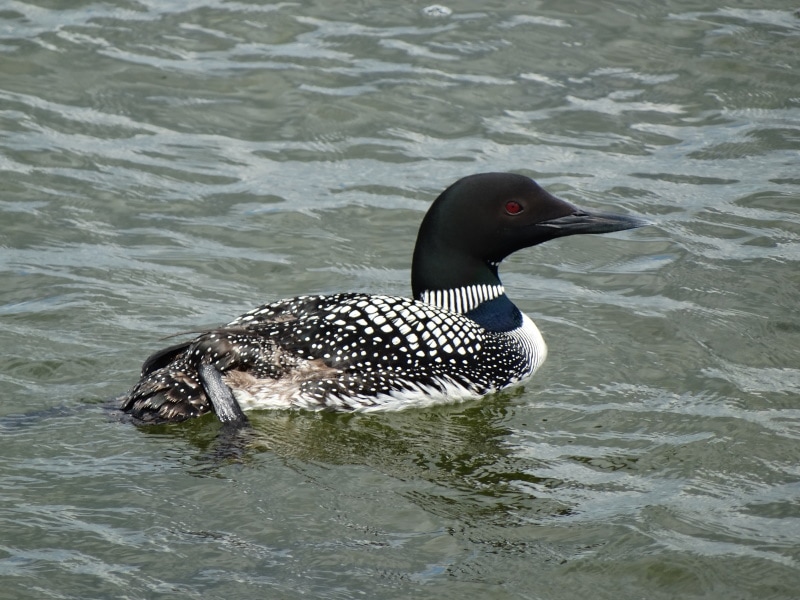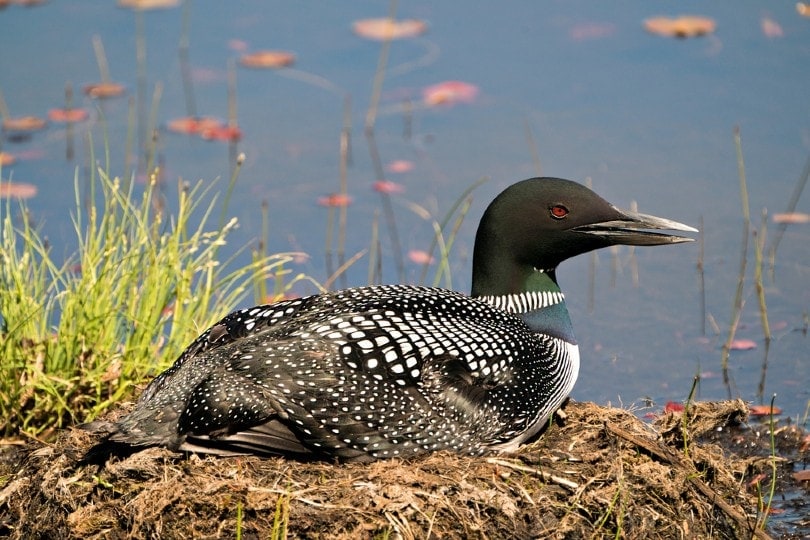Can Loons Fly? Do They Stay on Water?
Last Updated on

As opposed to most bird species, loons have solid bones. Their bones make them less buoyant, allowing them to maneuver through the water. Moreover, their far set-back legs help them move through the water effectively.
While loons tend to stay in the water most of the time, they can fly, too. They can reach a speed of up to 70 miles an hour. Since they have heavy bodies, loons need a ”runway” for flight. They need about a quarter of a mile to take off. So, if you see a loon swimming in the water with its head held high, it is probably preparing for flight.

How Do Loons Fly?
The hardest part about flying for a loon is getting up in the air. Their heavy bodies make it difficult for them to take off. To help themselves, they often swim quickly toward the shore and use the land to push off and get airborne. Once they’re in the air, they use their long, mighty wings to glide and soar.
They can fly for hundreds of miles without stopping. However, migration is energy-intensive, and they have to eat a lot to keep going.
They can stay in the air for hours at a time but usually only fly for short distances before landing on the water to rest and eat. When landing, they look for a lake or large body of water since they need a long, smooth surface to touch down on.
Loons are excellent flyers and can reach high speeds in the air. For example, they can reach speeds of up to 70 miles per hour when flying. But when they’re on the water, they’re much slower.
Their webbed feet act like paddles, and they use them to row through the water. They can also use their feet to dive under the water to catch fish.

Do Loons Stay on Water?
Loons spend most of their time on lakes and other bodies of water. They are strong swimmers and can stay underwater for several minutes at a time. Loons only come ashore to nest and usually only do so on islands or areas where there are no predators. When loons are on the water, they often float low in the water with just their head and neck sticking out. It helps them to be hidden from predators and also allows them to dive when they need to.
Loons are also known to bathe in water to clean their feathers. They also use bathing to remove parasites, such as lice, from their feathers.
When bathing, loons splash vigorously and often use their beak to submerge their head underwater. Loons will sometimes dive underwater and then come up quickly, spraying water all over their bodies.
How Do Birds Stay on Water?
Aquatic birds have special characteristics that allow them to stay on top of the water. For example, their feathers are oily, repelling water. Also, their feet have webs that act like paddles.
Some ducks even have a third eyelid that helps them see underwater. Birds that frequent the water also have waterproofing capabilities in their bills. It helps them prevent infection and keep their eyes clean while swimming.
Another adaptation that helps aquatic birds stay on water is their buoyancy. Their bones are often hollow, which makes them lighter and able to float more easily. The buoyant air sacs in their bodies also help with this. In addition, some birds, such as penguins, have solid bones to help them dive deeper into the water in search of food.
It’s also interesting to note that not all birds can land on water. Only the birds that can float well and have webbed feet can do this.

Why Do Loons Fly?
The most common reason for loons to fly is migration. They fly south for the winter and north for the summer. Breeding loons leave their lakes in late October and migrate to the ocean. When the breeding season begins in late spring and early summer, these loons return to the northern lakes and rivers. Here, they find their mates and build their nests. Some loons, however, will stay on the ocean year-round if they find an area with an abundance of food.
Loons can fly long distances in a single day. A documented case showed a loon covering a distance of 670 miles in 24 hours. Likewise, in another case, a loon covered a distance of 360 miles in one day and 505 miles the next day.
Another reason loons might fly is to find a new place to live. For example, if their lake dries up or gets too crowded, they will fly to a new one. Loons also fly to escape predators. If they are being chased by an animal on the ground, they can fly to safety. Meanwhile, if an animal is chasing them in the air, such as a hawk, they can dive into the water to escape.
Loons are also known to fly for the sheer joy of it. They have been seen flying in formation and doing barrel rolls.
Do Young Loons Fly?
Loon chicks do not start flying as soon as they hatch. Instead, they ride on the back of their parents.
There are two main reasons for the chicks back riding rather than swimming. First, it keeps the chick warm due to the parent’s body heat. Second, it provides some protection from predators.

Loons typically start flying around the age of 6–8 weeks. By this time, they are big enough, and their feathers have grown enough to provide lift. Initially, they have immature feathers that cannot provide the necessary insulation for long-distance flying. For this reason, young loons stay close to their parents until their first winter.
By the time they are 11 weeks old, their feathers are fully developed, and they are ready to fly south for the winter. If a young loon cannot fly south with its parents, it will most likely not survive the winter.

Frequently Asked Questions
Why Do Loons Need a Runway?
Their large body makes it hard for loons to get into the air. Thus, they need a long stretch of water to get enough speed to take flight. A loon will oftentimes run across the surface of the water to help them take off. They also need a runway to land because they cannot slow down quickly enough to land on the water.
Can Loons Walk?
Loons cannot walk on land. They’ll only come to land to nest and die. For the rest of their lives, they stay in the water, where they can swim and dive.

Do Loons Sleep in Water?
Yes, loons sleep in the water because their bodies are not adapted for life on land. They take short 15-minute naps in the water. When they have to sleep, loons turn their necks, folding their heads down and resting them on their backs.
What Is Happening When a Loon Flaps Its Wings?
The Common Loon flaps its wings to get enough speed and momentum for liftoff. Then, it will flap its wings 30 yards across the water surface, using it as a runway to take off.

Final Thoughts
As established, loons can fly. In fact, they’re brilliant fliers, traveling long distances in a single flight. However, they spend most of their lives in water, where they sleep, forage, and mate. Their legs are adapted for swimming, not walking, so they can only come to land to nest or die.
Featured Image Credit: Brian Lasenby, Shutterstock
About the Author Jeff Weishaupt
Jeff is a tech professional by day, writer, and amateur photographer by night. He's had the privilege of leading software teams for startups to the Fortune 100 over the past two decades. He currently works in the data privacy space. Jeff's amateur photography interests started in 2008 when he got his first DSLR camera, the Canon Rebel. Since then, he's taken tens of thousands of photos. His favorite handheld camera these days is his Google Pixel 6 XL. He loves taking photos of nature and his kids. In 2016, he bought his first drone, the Mavic Pro. Taking photos from the air is an amazing perspective, and he loves to take his drone while traveling.
Related Articles:
10 Types of Hummingbirds in Arkansas (With Pictures)
8 Types of Hummingbirds in Nebraska (With Pictures)
5 Types of Hummingbirds in Idaho (With Pictures)
3 Types of Hummingbirds in Mississippi (With Pictures)
8 Types of Hummingbirds in Kansas (With Pictures)
5 Types of Hummingbirds in West Virginia (With Pictures)
5 Types of Hummingbirds in Ohio (With Pictures)
Where Do Nuthatches Nest? Nuthatch Nesting Habits Explained
